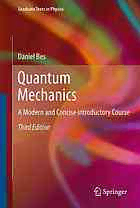
Quantum mechanics: a modern and concise introductory course PDF
Preview Quantum mechanics: a modern and concise introductory course
Graduate Texts in Physics Graduate Texts in Physics Graduate Texts in Physics publishes core learning/teaching material for graduate- and advanced-level undergraduate courses on topics of current and emerging fields within physics,bothpureandapplied.ThesetextbooksservestudentsattheMS-orPhD-leveland theirinstructorsascomprehensivesourcesofprinciples,definitions,derivations,experi- mentsandapplications(asrelevant)fortheirmasteryandteaching,respectively.Interna- tionalinscopeandrelevance,thetextbookscorrespondtocoursesyllabisufficientlytoserve asrequiredreading.Theirdidacticstyle,comprehensivenessandcoverageoffundamental materialalsomakethemsuitableasintroductionsorreferencesforscientistsentering,or requiringtimelyknowledgeof,aresearchfield. SeriesEditors ProfessorWilliamT.Rhodes FloridaAtlanticUniversity DepartmentofComputerandElectricalEngineeringandComputerScience (cid:127) ImagingScienceandTechnologyCenter 777GladesRoadSE,Room456 BocaRaton,FL33431,USA E-mail:[email protected] ProfessorH.EugeneStanley BostonUniversity CenterforPolymerStudies DepartmentofPhysics 590CommonwealthAvenue,Room204B Boston,MA02215,USA E-mail:[email protected] ProfessorRichardNeeds CavendishLaboratory JJThomsonAvenue CambridgeCB30HE,UK E-mail:[email protected] PleaseviewavailabletitlesinGraduateTextsinPhysicsonserieshomepage http://www.springer.com/series/8431/ Daniel R. Bes Quantum Mechanics A Modern and Concise Introductory Course ThirdEdition With 63 Figures 123 Daniel R.Bes ComisionNacionaldeEnergiaAtomica Av.GeneralPaz1499 1650Prov. de Buenos Aires, Argentina Universidad Favaloro Solis 453 1078 C.A.B.A., Argentina ISSN1868-4513 e-ISSN1868-4521 ISBN978-3-642-20555-2 e-ISBN978-3-642-20556-9 DOI10.1007/978-3-642-20556-9 Springer Heidelberg Dordrecht London New York Library of Congress Control Number: 2012938371 ©Springer-VerlagBerlinHeidelberg2004, 2007, 2012 This work is subject to copyright. All rights are reserved, whether the whole or part of the material is concerned,specificallytherightsoftranslation,reprinting,reuseofillustrations,recitation,broadcasting, reproductiononmicrofilmorinanyotherway,andstorageindatabanks.Duplicationofthispublicationor partsthereofispermittedonlyundertheprovisionsoftheGermanCopyrightLawofSeptember9,1965,inits currentversion,andpermissionforusemustalwaysbeobtainedfromSpringer .Violationsareliable to prosecutionundertheGermanCopyrightLaw. Theuseofgeneraldescriptivenames,registerednames,trademarks,etc.inthispublicationdoesnotimply, evenintheabsenceofaspecificstatement,thatsuchnamesareexemptfromtherelevantprotectivelawsand regulationsandthereforefreeforgeneraluse. Coverdesign: eStudio Calamar Steinen Printedonacid-freepaper SpringerispartofSpringerScience+BusinessMedia(www.springer.com) Aprimevalrepresentationofthehydrogenatom This beautiful mandala is displayed at the temple court of Paro Dzong, the monumental fortress of Western Bhutan [1]. It may be a primeval representation of the hydrogen atom: the outer red circle conveys a meaning of strength, which maycorrespondtothe electronbindingenergy.Theinnerandsphericalnucleusis surroundedbylarge,osculatingcirclesthatrepresentthemotionoftheelectron:the circlesnotonlyoccupyafiniteregionofspace(asinFig.6.4)butarealsoassociated with trajectories of different energies (colors) and/or with radiation transitions of different colors (wavelengths). At the center, within the nucleus, there are three quarks.Realitycandisplaycharmingcoincidenceswithreligious/artisticcreations. Seealsofigureattheendofthechapters. v (cid:127) Foreword Quantummechanicsisundergoingarevolution.Notthatitssubstanceischanging, but major developments are placing it in the focus of renewed attention, both withinthephysicscommunityandamongthescientificallyinterestedpublic.First, wonderfully clever table-top experiments involving the manipulation of single photons,atomic particles and molecules are revealingin an ever-moreconvincing manner theoretically predicted facts about the counterintuitive and sometimes “spooky” behavior of quantum systems and have led to a renewed interest in the formulationofastrictlyphysics-based(non-philosophical)foundationofquantum mechanics.Second,theprospectofbuildingquantumcomputerswith enormously increasedcapacityof information-processingis developinggreatinterestand high hopes in the engineering and computer science communities. Third, condensed matterphysicsandnanotechnologyare narrowingdownthe gapbetweenclassical and quantum domains in the practical realm. These developments demand more and better training in quantum mechanics at the universities, with emphasis on a clear and solid understandingof the subject. Cookbook-stylelearning of quantum mechanics,inwhichequationsandmethodsfortheirsolutionarememorizedrather thanunderstood,may helpthe studentsto solve somestandardproblemsand pass multiple-choice tests, but it will not enable them to break new ground in real life as physicists. On the other hand, some “Mickey Mouse courses” on quantum mechanicsforengineers,biologistsandcomputeranalystsmaygiveanideaofwhat thisdisciplineisabout,buttoooftenthestudentendsupwithanincorrectpictureor, at best, a bunch of uncritical,blind beliefsin linear algebrawizardry.The present book represents a fresh start toward helping achieve a deep understanding of the subject. It presents the material with utmost rigor and will require ironclad, old- fashioneddisciplinefromthestudentsintheirstudy. Too frequently, in today’s universities, we hear the demand that the courses offeredbe“entertaining,”inresponsetowhichsomedepartmentalbrochuresdeclare that “physics is fun”! Studying physics requires many hours of hard work, deep concentration, long discussions with buddies, periodic consultation with faculty, and tough self-discipline. But it can, and should, become a passion: the passion toachievea deepunderstandingofhowNatureworks.Thisunderstandingusually vii viii Foreword comes in discrete steps, and students will experience such a step-wise mode of progressastheyworktheirwaydiligentlythroughthepresentbook.Thesatisfaction ofhavingsuccessfullymasteredeachstepwillthenindeedfeelveryrewarding! The“amountofinformationperunitsurface”oftextisveryhighinthisbook– its pagescoverall the importantaspectsof present-dayquantummechanics,from theone-dimensionalharmonicoscillatortoteleportation.Startingfromafewbasic principles and concentrating on the fundamental behavior of quantum systems (particles)withonlyafewdegreesoffreedom(low-dimensionHilbertspace)allows the author to plunge right into the core of quantum mechanics. It also makes it possible to introduce first the Heisenberg matrix approach – in my opinion, a pedagogically rewarding method that helps sharpen the mental and mathematical tools needed in this discipline right at the beginning. For instance, solving the quantization of the harmonic oscillator without the recourse of a differential equation is illuminating and teaches dexterity in handling the vector and matrix representationofstatesandoperators,respectively. DanielBesisachildoftheCopenhagenschool.Honedinoneofthecradlesof quantummechanicsby A˚ge Bohr,son of the greatmaster, andby Ben Mottelson, hedevelopedanunusuallyacuteunderstandingofthesubject,whichafteryearsof maturinghenowhasprojectedintoabook–nowinitsthirdedition.Theemphasis giventhroughoutthetexttothefundamentalroleandmeaningofthemeasurement process will help the student overcome the initial reaction to the counterintuitive aspects of quantum mechanics and better comprehend the physical meaning and properties of Schro¨dinger’s wave function. The human brain is an eminently classicalsystem(albeitthemostcomplexoneintheUniverseasweknowit),whose phylo-andontogeneticevolutionaredrivenbyclassicalinteractionsbetweenorgan- ism and the environment, and which processes pragmatic information, definable onlyintheclassicaldomain.Itisthereforeonlynaturalthatwhenthisclassicalbrain looksintothemicroscopicdomain,usinghuman-designedinstrumentswhichmust translate quantum happenings into classical, microscopically observable effects, strangethingswithunfamiliarbehaviormayappearinourmentalimages!Anditis onlynaturalthat,thus,theobserver’swayofthinkingandinstrumentsshouldnotbe leftcompletelyoutsidethefundamentalframeworkofquantumphysics!Bes’book helpstorecognize,understandandacceptquantum“paradoxes”notassuchbutas thefactsof“Natureunderhumanobservation.”Oncethisacceptancehassettledin themind,thestudentwillhavedevelopeda trueintuitionor,astheauthorlikesto callit,a“feeling”forquantummechanics. Chapter 2 contains the real foundation on which quantum mechanics is built; it thus deserves, in my opinion, repeated readings – not just at the beginning but after each subsequent chapter. With the exception of the discussion of two additionalprinciples,therestofthebookdescribesthemathematicalformulations of quantum mechanics (both the Heisenberg matrix mechanics, most suitable for the treatment of low-dimension state vectors, and Schro¨dinger’s wave mechanics for continuous variables) as well as many up-to-date applications. The examples cover a wide variety of topics, from the simple harmonic oscillator mentioned abovetosubjectsincondensedmatterphysics,nuclearphysics,electrodynamicsand
